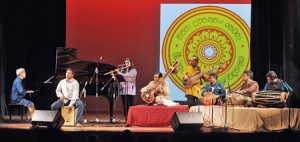Breaking free! Musically speaking
View(s):It was dark all around.
There was frost in the ground
When the tigers broke free.
(Pink Floyd, When the Tigers Broke Free)
If taken out of its context (only until the end of this review!) the above-quoted lyrics from the incensed and infuriated anti-war theme of the psychedelic-rock band (notice the fusion: psychedelic + rock) Pink Floyd would serve a symbolic purpose to articulate an event whose core meaning would be better left unarticulated.
The event under focus is a Sitar-Piano concert titled Serendip. As per the song lyrics, the theatre was dark — except for the glow-wormed effects of the ubiquitous SMART phones! — and there was rain all over the town.
Two performers, famed for their ability to transcend the traditions of their respective disciplines, broke free using sound, sense and synthesis.
Pradeep Ratnayake, the sitarist, possibly does not need a special introduction – but, for the purpose of this review it would suffice to say that, he is a sitarist who has imaginatively applied his Indian classical training into hitherto unexplored musical horizons.
The Japanese pianist, Masahiko Satoh, is an artist, who has transcended the enigma of unimpeachable Jazz – thus he is called a ‘Free’ jazz pianist. They broke free at the Wendt on an evening – and, they were only inadequately opposed by unruly weather.
If there was anticipation about the nature of sound that would result from the intimacy between the sitar and the piano, possibly it would have been a question mark ???. Those question marks could have been displaced after the first half of the concert, where the piano and sitar engaged in solo as well as combined flights of explorations and excursions.
Song for Madhu, the concert opener, was a fervent, passionate lyrical melody, driven by the sitar and gently pursued by the piano. The sitar introduced the main motif of the song – an adoring , emotive and stirring melodic sensation – and the piano provided the reassuring backdrop and remained at a distance, while frequently humming its presence.
Piano Solo, the second item of the concert, was a soul-driven voyage whose controlled intensity was only complemented by its daring range of expressions.
The solo flight refused to be drawn into genres, but at the same time, with profundity and rare refinement acknowledged the genres by weaving them into its womb — the resulting sound was sincere, philosophical and substantial. In the Blue Flight of Fancy, there was stark contradiction of words and music.
| Concert facts Concert: Serendip – Pradeepanjalee |
The expectation of the title was a movement upward (‘flight’) and possibly a fantasy (‘fancy’) and may be a pentatonic outburst. Alas, what happened was none of the above – but an outpouring of extraordinary sentiments where the music displaced the performers.
Music invented itself out of nothing, and began to evolve stealthily until it arrived at a point of no return; then the boundaries blurred as the instruments, performers and the audience collapsed. The music lived. The totality of this flight was an outstanding fusion of the known and the unknown, spirituality and secularity and meaning and fragmentation.
Natya Rasa had a tabla on stage – and while the sitar became the singer, the tabla assumed the role of the singer’s heart with its consistent and healthy rhythmic palpitations. The sitar’s potentiality for voice was exceptionally demonstrated by Pradeep, as he deftly articulated words and phrases from the nadagam and nurthi gee through the sitar.
Natya Rasa, though its original intentions – declared on the concert notes – was to fuse the world of music into its fold, actually succeeded in executing an unplanned drama: re-enacting and resurging the drama element of the nadagam and nurthi gee and converting them to something astonishing and bewildering.
There was a whisper gently floating in the audience that the second session of the show would project the ultimate power of the performance – and that whisper had its own sense of truth.
In addition to three more fusion solos of the sitar and the piano, this session saw the galloping, hurtling, fluttering and dashing Vannama motifs given a fresh impetus and interpretation.
Flight of the Hawk, a graceful and chic theme, based on the Ukusu Vannama, with sitar taking flight upon the percussion-and-base-guitar-driven wind beneath the wings did not only provide sound sensation, but visual as well: imagine — a sitar, tabla, gatabera, tammatama and udakki and a bass guitar in one space crafting the subtle and graceful movements of a bird whose flight has entrenched itself in the souls of many a man (and a woman!) of words.
Stallions, another similar endeavor based on the Thuranga Vannama, had additional air supply from a flute, thus blending strings, wind, percussion and piano into a gentle charge of a light brigade. There was sheer authenticity and certainty in its equestrian pitch and timbre.
The totality of sound, or the final outcome of the diverse musical voices of this concert, carried inexorable power of poetry: wholesome outpouring of tranquility complemented by controlled agitation – and in that final totality (and tonality) there was neither East, nor West.


